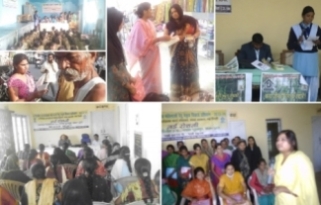SEVAK
Samaj Kalyan Evam Vikas Adhyayan Kendra
Health
India's accelerated population growth since 1951 was on account of sharp declines in mortality without concomitant declines in fertility. The National Health Policy in 1983 had laid down specific targets for fertility reduction, which aimed at replacement level fertility by year 2000. Despite concerted efforts in the form of national programmes on family planning, child survival and safe motherhood, mother and child health, universal immunization of children, etc., which were intended to impact fertility through its crucial determinants, attempts have not succeeded in bringing down fertility to the replacement levels for India. While replacement level fertility levels have been achieved in some larger states like Kerala and Tamil Nadu, this has not been possible in case of larger and most populated states.
With the largest population size and highest fertility levels, Uttar Pradesh is the focus of attention in the attempted realisation of the National Population Policy goals. Paradigm shifts in India's population policies from those that were contraceptives-mix target oriented to the target free approach in April 1996 followed thereby by the client-centred-demand driven community needs assessment (CNA) approach during late 1997 have led to an emphasis on the RCH services package. Stress on the same has been reiterated in the population policy statement of Uttar Pradesh.
The demographic backwardness of UP is characterised by most demographic parameters such as: high fertility with a total fertility rate (TFR) of 4.8; relatively much higher levels of infant mortality of 85 per thousand births; maternal mortality ratio of 707; much lower level of contraceptive prevalence rate of 38 per cent; etc. Furthermore, UP's performance for reproductive and child health (RCH) parameters like utilization of complete antenatal care is only 5 per cent compared to India's 15 per cent, children's complete immunization is just 17 per cent compared to India's 53 per cent; the unmet need for contraception is 47 per cent compared to India's 27 per cent, almost completed fertility characterised by the mean children ever born to currently married women aged 40-44 years turns out to be 5.8 compared to India's 4.5.
It is in this backdrop that SEVAK is intervening in RCH sector in Kheri district, which is adjacent to Pilibhit district, headquarters of the organisation. It is imparting complete RCH Phase II services, including narrative & curative health services of health post, and referral services for high risk cases, in unserved rural areas in the district Lakhimpur Kheri funded by World Bank aided project of UPHSDP.
The organisation has been selected as a trainer organisation by reputed organisations like CARE-India to provide training of trainers for their immunisation programme. Capacity of ANMs and AWWs being built upon for better implementation and management of Vitamin A supplementation and immunisation work. ToT program of USAID micro-neutrant program funded by MOST-INDIA, now working in NRHM as District action plan in Pilibhit, and project proposal of HIV/AIDS prevention in HRG as TIP Project of NACO/SACS.
